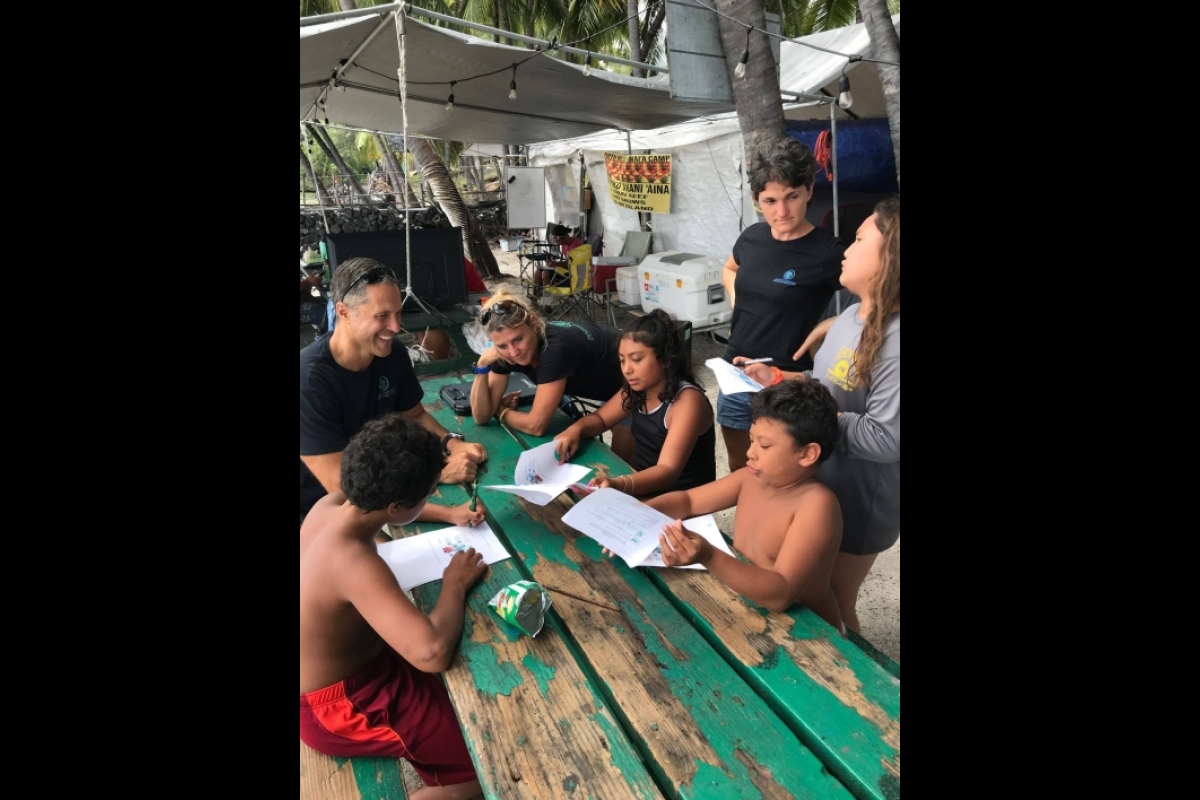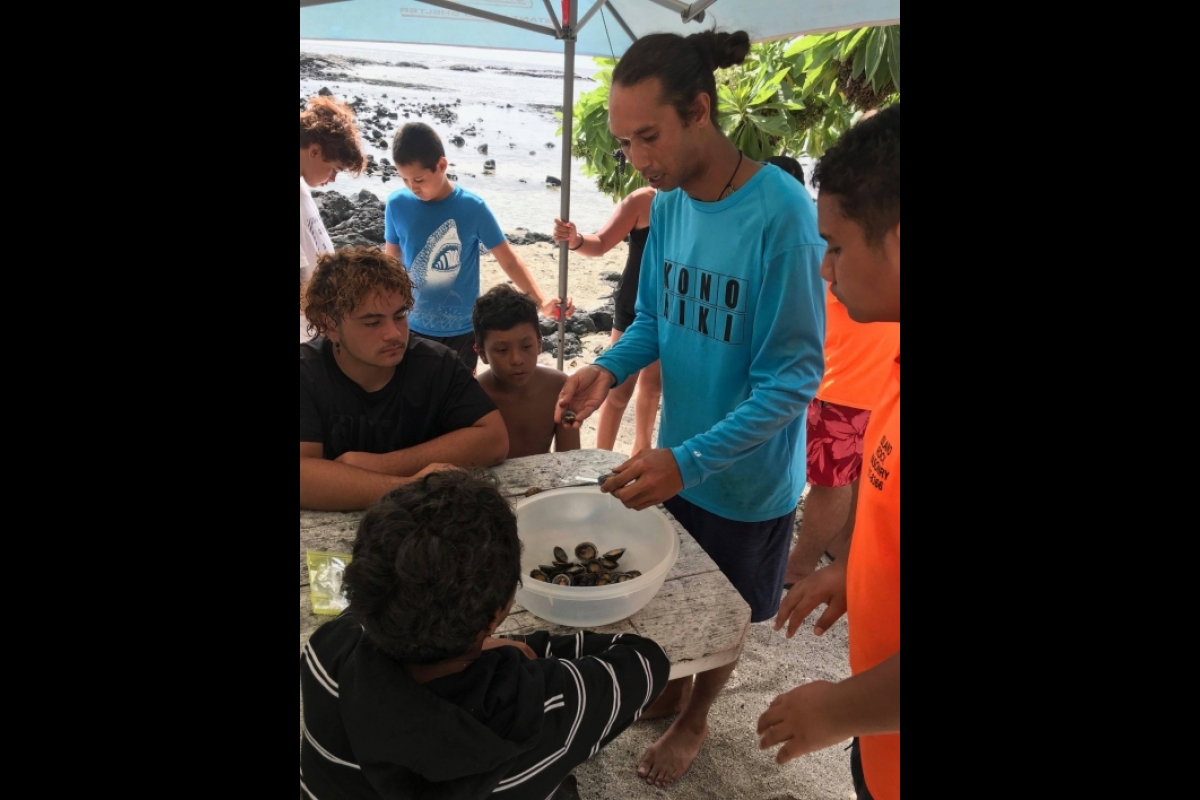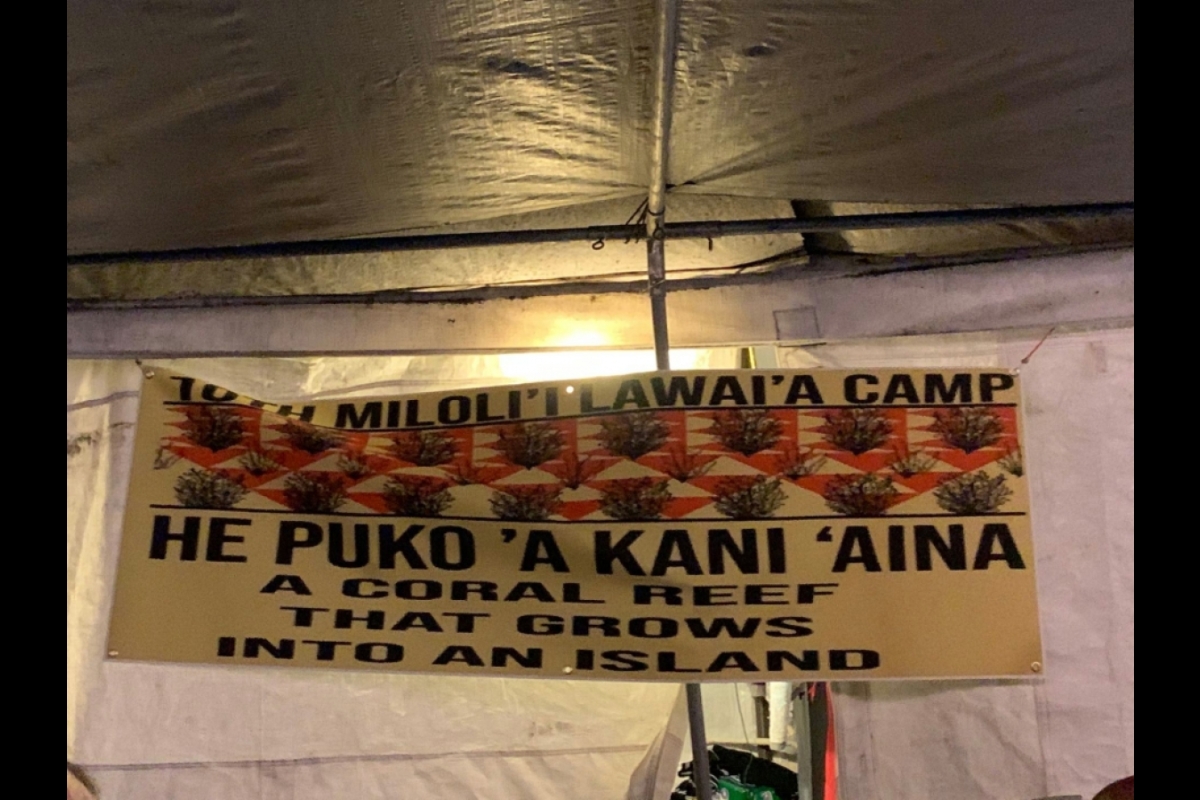Tempe to Hawaii: ASU professors teach Hawaiian youth about coral reef conservation

Lawaiʻa ʻOhana Camp students, teachers, camp leaders and parents. Photo courtesy of Greg Asner and Robin Martin
Against a backdrop of a clear blue sky, slender palm trees and waves crashing against black lava rocks along Hawaii’s South Kona coastline, a dozen youths ages eight to 17 sat silent and wide-eyed as Greg Asner and Robin Martin told stories of deep underwater dives and aerial missions to protect and save Hawaii’s coral reefs.
Asner, director of ASU’s Center for Global Discovery and Conservation Science (GDCS) and professor in the School of Geographical Sciences and Urban Planning, and Martin, associate professor in the School of Geographical Sciences and Urban Planning, were volunteer teachers this summer at South Kona’s Lawaiʻa ʻOhana Camp.
The multiday immersion offered children in the coastal fishing village of Miloliʻi the opportunity to learn about Indigenous island culture, local traditions, and environmental research and stewardship.
“We taught them about different types of Hawaiian corals, what they are and why they are important,” said Asner, who specializes in marine ecology and remote sensing. “It was so uplifting in so many ways. The kids were phenomenal, they took ownership of their new knowledge. Nothing was passive. All active.”
In addition to the students there in person, 30 more students living in other regions of Hawaii joined virtually via Zoom and Facebook Live, due to COVID-19 safety measures.
“The students were super excited, particularly to learn that you can map coral cover from an airplane and that the area of West Hawaii where they live ranks fifth for highest coral cover across all of Hawaii,” said Martin, a biochemist and remote sensing expert. “My favorite moment was when the students were all asked to reflect and share about what they learned throughout the entire camp. Over half the students said different aspects of coral. We made it exciting. That felt really good.”
Asner and Martin’s participation in the camp is just one piece of an important partnership that places ASU in the center of important work to break down geographic barriers to education and expand opportunities to Native and non-Native Hawaiian communities.
A community united
Asner and Martin, who are husband and wife in addition to being a research duo, have studied coral reefs across the Hawaiian islands for more than two decades.
Currently, within ASU’s GDCS they are pioneering research aimed at mapping coral reef ecosystems that address alarming losses in coral biodiversity. By integrating high-tech airborne data on corals with fieldwork on the fish that occupy the reef, Asner and Martin are helping Hawaii state managers to identify areas for conservation.
In a collaborative approach to regional ecological research, GDCS partners with the local Hawaiian community organization Paʻa Pono Miloliʻi to intersect traditional Hawaiian knowledge with contemporary science as it relates to coral reef and fisheries conservation and management.
The work not only promotes scientists and local communities working together but ensures that Native culture, customs and traditions are considered in coral reef resilience planning.
The long-standing partnership has already generated a range of conservation activities, including local programs and training at every stage of a student’s educational journey from youth to PhD education.
Asner says one hope of the partnership is that expanding local learning opportunities could spark interest in local science and conservation and help usher in a new generation of native Hawaiian environmental resource managers.
“Many local Hawaiians have been excluded from the state-level processes of reef management,” Asner said. “So we are going to the youth and participating in education and capacity-building at all levels, from K to PhD. The Lawaiʻa Camp was about the earliest stage of interaction between ASU-GDCS, Paʻa Pono Miloliʻi and the community.”
ASU’s expanded opportunities in Hawaii
In leading this important work to extend education across Hawaii, Asner and Martin are not alone.
Jody Kaulukukui, senior advancement officer for ASU Foundation, has been leading critical work around making ASU’s K-12 online school platform, ASU Prep Digital, available to the communities in Hawaii that may need and benefit from it most.
Additionally, Asner and others have been leading educational efforts to promote ASU Online’s bachelor’s degree program in geography across Hawaii.
“We’re scratching at this and it’s early days but that’s where we’re taking it,” Asner said. “We’re trying to break the barrier, even the playing field, and give communities more uniform access to different types of learning so they can grow their knowledge in their areas of interest.”
Additional ASU support also comes from faculty and staff in ASU’s Global Institute of Sustainability and the Julie Ann Wrigley Global Futures Laboratory at ASU.
“We’re working hard here to generate connections, and we have a constellation of ASU people working on this together,” Asner added.
Measured by whom we include
Despite their packed schedules as full-time faculty and field-researchers, Asner says the Hawaiian community work he, Martin and others from ASU are leading is important, not only for its societal impact but as a commitment to living out ASU’s charter, which prioritizes the inclusion of all diverse peoples regardless of age, location and background.
“While we may not generate immediate ASU students by doing work with K–12, we know we are generating future students,” Asner said. “ASU is now known and liked in far reaches of Hawaii, like Miloliʻi, in part, because we are here and we are focused on their future.
“The reward is huge from the mind to the heart. We love being part of the broader solution that President Crow has laid out for us to pursue. Every extra hour continues to pay off in spades.”
More Environment and sustainability

'Earth Day Amplified' promotes power of collective action
Everybody loves the concept of sustainability. They want to do their part, and the chance to say they’ve contributed to the well-…

Rethinking Water West conference explores sustainable solutions
How do you secure a future with clean, affordable water for fast-growing populations in places that are contending with unending…
Meet the young students who designed an ocean-cleaning robot
A classroom in the middle of the Sonoran Desert might be the last place you’d expect to find ocean research — but that’s…




